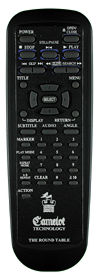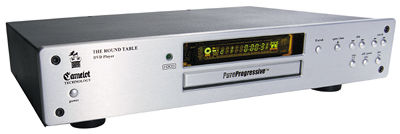Camelot Technology Round Table DVD player Page 3
As I reported in my review of the Ayre D-1 in the February issue, I compared the Dolby Digital/DTS output of the Round Table with the Ayre's into the digital input of the Denon AVR-5800 (reviewed in our March/April issue). I was surprised to find that the Ayre, with its transformer-coupled output, sounded somewhat better—but then, it sounds better than most DVD players I've heard in that regard, and that the RT's Dolby Digital/DTS output sounds comparable to other good DVD players.
 While the Round Table didn't sound quite as good as the Ayre D-1 when used as a CD player, it was close—which makes it one of the finest-sounding CD players I've heard, with all of the attributes of a top-quality high-end player: well-controlled and extended bass, liquid midrange, airy and detailed highs, low distortion, and wide dynamic range. The RT produced a 3-dimensional soundstage (at least, as 3-dimensional as CD sound gets) and very fine image focus and resolution of inner detail. It had the overall sonic effortlessness I've heard only from the better high-end CD players.
While the Round Table didn't sound quite as good as the Ayre D-1 when used as a CD player, it was close—which makes it one of the finest-sounding CD players I've heard, with all of the attributes of a top-quality high-end player: well-controlled and extended bass, liquid midrange, airy and detailed highs, low distortion, and wide dynamic range. The RT produced a 3-dimensional soundstage (at least, as 3-dimensional as CD sound gets) and very fine image focus and resolution of inner detail. It had the overall sonic effortlessness I've heard only from the better high-end CD players.
I was so impressed with the sound that I took the Round Table downstairs to my 2-channel audio room and used it there when I wasn't watching movies. I'm not convinced that upsampling actually improves the sound, but it clearly changes it, and with many discs, the change effected by the RT was for the better. And it was nice to be able to decode HDCDs—something the $11,500 Ayre can't do.
But unless your preamp-processor or receiver can route a pure analog signal to the amplifiers, all of this sophisticated circuitry will be wasted: the sound will be only as good as the A/D and D/A converters built into your electronics.
Too Much of a Good Thing?
The Camelot Round Table's versatility is either a strong selling point or its Achilles' heel. If all you want is a high-quality progressive-scan DVD player for watching movies, you might feel you're paying for a lot for a state-of-the-art CD player you really don't want or need, and unnecessary features like powered S-video. You might wonder how much the RT would cost with Panasonic's 24/96 D/A circuitry left intact, and without powered S-video and the I2S bus. You might question Camelot's kitchen-sink approach to design, and wonder whether you want to spend $4000 on a modified Panasonic A-110.
But if you're like me, you're thinking about that Squeeze mode and how it solves a big problem for you as you consider buying a progressive-scan DVD player for your HDTV that doesn't let you scale the picture in the progressive-scan input. That, and the Round Table's superb video performance, make it well worth considering, even at its steep price.

Conclusion
Starting with a humble but well-executed DVD player, Camelot Technology has built—almost from the ground up—a progressive-scan DVD player based on a DVDO chip, and a CD player packed with options and features. Although calling the resulting Round Table a "modified" Panasonic A-110 doesn't do it justice, you'll still have to live with a less-than-ideal remote and a less-than-stellar transport in any mode other than Play. However, the Squeeze-mode button alone should make this player an extremely attractive choice for many HDTV owners.
The Round Table is a DVD player designed for the very critical audio/videophile. Whether or not you fit that profile, you have to love a company that has the guts to build and market such a product. And if you get a chance to see the superb picture the Round Table produces, you'll love that too.













































